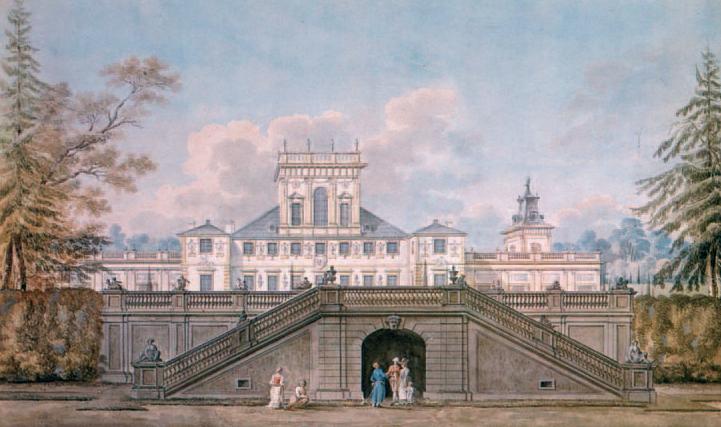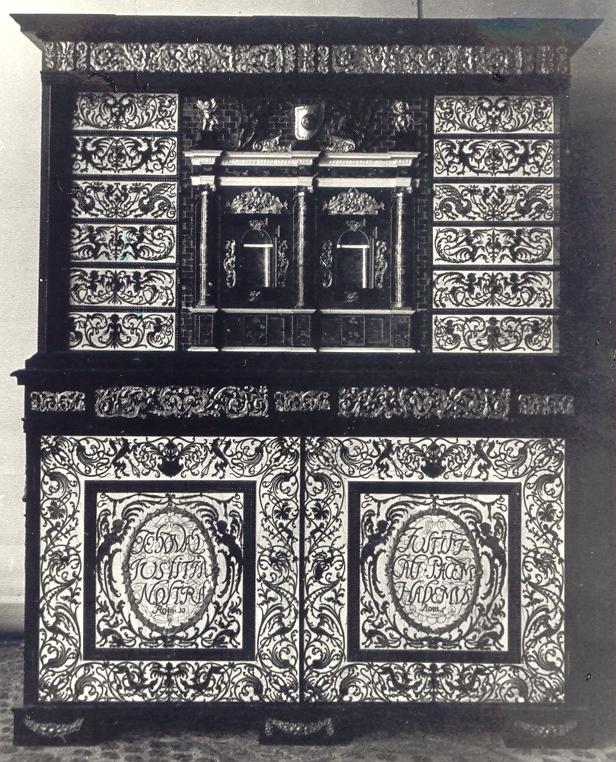Wilanów on:
[Wikipedia]
[Google]
[Amazon]
Wilanów () is a
 In the 17th century the village was bought by the family of Stanisław Leszczyński, who started the construction of a new palace; however, the works were stopped by The Deluge when the forces of
In the 17th century the village was bought by the family of Stanisław Leszczyński, who started the construction of a new palace; however, the works were stopped by The Deluge when the forces of Tylman of Gameren
at the Wilanów Palace Museum and St. Anne's Church. Initially the palace was named ''Villa Nova'' (''New Village''), to distinguish it from the nearby village of ''Stara Wieś'' (''Old Village''). However, soon the name was polonised to Wilanów, similar to the former name Milanów. Thanks to the proximity of both the kings' summer residence and the city of In 1863, after the fall of the
In 1863, after the fall of the 
Wilanów webpage
The Wilanów Palace Museum
Wilanów Poster Museum
Wilanów Police Station
{{DEFAULTSORT:Wilanow
district
A district is a type of administrative division that, in some countries, is managed by the local government. Across the world, areas known as "districts" vary greatly in size, spanning regions or counties, several municipalities, subdivision ...
of the city of Warsaw
Warsaw ( pl, Warszawa, ), officially the Capital City of Warsaw,, abbreviation: ''m.st. Warszawa'' is the capital and largest city of Poland. The metropolis stands on the River Vistula in east-central Poland, and its population is officiall ...
, Poland
Poland, officially the Republic of Poland, is a country in Central Europe. It is divided into 16 administrative provinces called voivodeships, covering an area of . Poland has a population of over 38 million and is the fifth-most populou ...
. It is home to historic Wilanów Palace, the "Polish Versailles
The Palace of Versailles ( ; french: Château de Versailles ) is a former royal residence built by King Louis XIV located in Versailles, about west of Paris, France. The palace is owned by the French Republic and since 1995 has been managed, ...
," and second home to various Polish kings.
History
The first mentions of a settlement in the area can be traced to the 13th century, when a village named ''Milanów'' was founded by theBenedictine
, image = Medalla San Benito.PNG
, caption = Design on the obverse side of the Saint Benedict Medal
, abbreviation = OSB
, formation =
, motto = (English: 'Pray and Work')
, foun ...
monastery of Płock. In 1338 it became a private property of the Dukes of Mazovia
Duke of Masovia ( pl, Książę Mazowsza) was a title born by the sons and descendants of the Polish Duke Bolesław III Wrymouth. In accordance with the last will and testament of Bolesław, upon his death his lands were divided into four to five ...
and in 1378 Prince Janusz I of Warsaw gave it to one of his servants. It was he who established the first mansion and a chapel in the village. His descendants adopted the name ''Milanowski'', after the name of the village.
 In the 17th century the village was bought by the family of Stanisław Leszczyński, who started the construction of a new palace; however, the works were stopped by The Deluge when the forces of
In the 17th century the village was bought by the family of Stanisław Leszczyński, who started the construction of a new palace; however, the works were stopped by The Deluge when the forces of Sweden
Sweden, formally the Kingdom of Sweden,The United Nations Group of Experts on Geographical Names states that the country's formal name is the Kingdom of SwedenUNGEGN World Geographical Names, Sweden./ref> is a Nordic countries, Nordic c ...
captured the area and plundered it completely. In 1676 the depopulated village was bought by King Jan III Sobieski. By his order, Tylman van Gameren and Augustyn Wincenty Locci erected the new baroque
The Baroque (, ; ) is a style of architecture, music, dance, painting, sculpture, poetry, and other arts that flourished in Europe from the early 17th century until the 1750s. In the territories of the Spanish and Portuguese empires including ...
-style palaceat the Wilanów Palace Museum and St. Anne's Church. Initially the palace was named ''Villa Nova'' (''New Village''), to distinguish it from the nearby village of ''Stara Wieś'' (''Old Village''). However, soon the name was polonised to Wilanów, similar to the former name Milanów. Thanks to the proximity of both the kings' summer residence and the city of
Warsaw
Warsaw ( pl, Warszawa, ), officially the Capital City of Warsaw,, abbreviation: ''m.st. Warszawa'' is the capital and largest city of Poland. The metropolis stands on the River Vistula in east-central Poland, and its population is officiall ...
, Wilanów has for ages been a suburb of Warsaw and a popular holiday spot for Polish magnates. It was also the final point on the historical Royal Road. In the 18th century, the palace became the property of Hetman
( uk, гетьман, translit=het'man) is a political title from Central and Eastern Europe, historically assigned to military commanders.
Used by the Czechs in Bohemia since the 15th century. It was the title of the second-highest military ...
Adam Mikołaj Sieniawski
Adam Mikołaj Sieniawski (1666–1726) was a Polish nobleman, aristocrat and military leader.
He was the son of Hetman Mikołaj Hieronim Sieniawski and Cecylia Maria Radziwiłł, daughter of Court and Grand Marshal Prince Aleksander Ludwik ...
. His widow, Elżbieta Sieniawska, joined the village with the nearby villages of Kabaty, Powsin and . After that both the so-called ''key'' of villages (group of villages run together by a common owner) and the palace changed hands several times, with each new owner changing something in the look of the palace.
January Uprising
The January Uprising ( pl, powstanie styczniowe; lt, 1863 metų sukilimas; ua, Січневе повстання; russian: Польское восстание; ) was an insurrection principally in Russia's Kingdom of Poland that was aimed at ...
, the Russia
Russia (, , ), or the Russian Federation, is a transcontinental country spanning Eastern Europe and Northern Asia. It is the largest country in the world, with its internationally recognised territory covering , and encompassing one-ei ...
n authorities introduced a new administrative division, stripping the ''key'' of the rest of villages and making Wilanów a capital of all the communes located south of it. The area became one of the most important providers of food for ever-growing Warsaw
Warsaw ( pl, Warszawa, ), officially the Capital City of Warsaw,, abbreviation: ''m.st. Warszawa'' is the capital and largest city of Poland. The metropolis stands on the River Vistula in east-central Poland, and its population is officiall ...
and in 1890 a horse-drawn railway was opened for transport of grain and passengers. The line linking Wilanów with Warsaw
Warsaw ( pl, Warszawa, ), officially the Capital City of Warsaw,, abbreviation: ''m.st. Warszawa'' is the capital and largest city of Poland. The metropolis stands on the River Vistula in east-central Poland, and its population is officiall ...
's Lublin Union Square proved to be a major success and in 1892 the line was extended and started to run steam-drawn trains. Also, new railway stations were built on both ends of the line.
After World War II
World War II or the Second World War, often abbreviated as WWII or WW2, was a world war that lasted from 1939 to 1945. It involved the World War II by country, vast majority of the world's countries—including all of the great power ...
the palaces in Wilanów, Natolin and Morysin were nationalised
Nationalization (nationalisation in British English) is the process of transforming privately-owned assets into public assets by bringing them under the public ownership of a national government or state. Nationalization usually refers to p ...
by the new communist authorities of Poland. The former was converted into a museum and in one of the palace's barracks a Museum of Poster
A poster is a large sheet that is placed either on a public space to promote something or on a wall as decoration. Typically, posters include both textual and graphic elements, although a poster may be either wholly graphical or wholly text ...
s was opened on 4 June 1968. It is probably the only such museum in Europe. In 1951 Wilanów was incorporated into Warsaw
Warsaw ( pl, Warszawa, ), officially the Capital City of Warsaw,, abbreviation: ''m.st. Warszawa'' is the capital and largest city of Poland. The metropolis stands on the River Vistula in east-central Poland, and its population is officiall ...
. Initially a separate unit of administrative division, in 1976 it was joined with the borough of Mokotów. In 1994 it became a separate unit of administrative division and the following year it became one of the boroughs of Warsaw.
Currently, the surrounding area is home to many expatriates living in Warsaw, as this area is home to many international schools. However, in 2000, the American School of Warsaw moved about 6 km out, to the suburb of Konstancin-Jeziorna.

Neighbourhoods within the district
* Wilanów Wysoki * Wilanów Niski * Wilanów Królewski * Błonia Wilanowskie * Powsinek * Zawady * Kępa Zawadowska * PowsinSee also
*Temple of Divine Providence
The Temple of Divine Providence ( pl, Świątynia Opatrzności Bożej) and Pantheon of Great Poles (in Polish, Panteon Wielkich Polaków, in southern Warsaw's Wilanów district, is a principal Roman Catholic church in Poland. The backstory of ...
*Museum of John Paul II and Primate Wyszyński
The Museum of John Paul II and Primate Wyszyński ( pl, Muzeum Jana Pawła II i Prymasa Wyszyńskiego) is a Roman Catholic cultural and educational institution affiliated with the Archdiocese of Warsaw, honoring two prominent Polish Catholic l ...
References
Inline General *External links
Wilanów webpage
The Wilanów Palace Museum
Wilanów Poster Museum
Wilanów Police Station
{{DEFAULTSORT:Wilanow